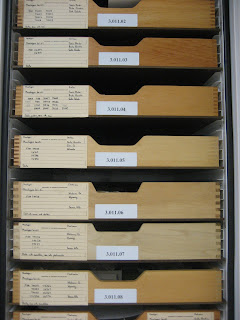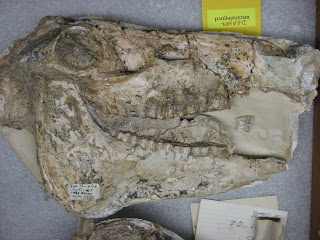
After the end of the initial eight week internship, Jessica and i stayed on for additional time. For the first two weeks, we worked together lining as many upper cabinets as we could! Jessica tied up the loose ends of her georeferencing and I began the task of combing through the localities spreadsheets for Ainsworth, Lusk, Skinner, Florida and Mongolia. A lot of sites required more attention, so the coordinate hunt ensued! After those weeks had passed, Jessica flew home to Chi Town for a brief respite before jet setting to Australia, where she will be residing with her sister for some time.
For the past six weeks since Jessica left, I have been the sole intern, working closely with volunteers and division staff. In continuing with georeferencing, some tricky locales have necessitated a whole new level of ingenuity. I've been finding a lot of information about the family names associated with different localities from local library records. Obituaries and other articles are great ways to link people to each other and to the land. The days of microforms such as microfiche and microfilm are behind us as access to public records news clippings is extensive on the internet. In one instance, an obituary led me to a folklore account that provided a surprisingly accurate geographic map and further, triangulated the position of an evasive locality. I have been working hard at patching up some holes in the georeferencing, further confirming web derived coordinates with information from specimens, shipping records, and other associated data as well as organizing this information into a format that is decipherable to the human eye and agreeable with PaleoCat, the Paleontology Division's specimen database.
Georeferencing is a somewhat new entity in the museum field that staff from all different divisions are interested in carrying out. It is invaluable to gain a full understanding of the source of the specimens in the collection. Before georeferencing, you might know specific locations for many specimens, but there are also going to be a lot of very unclear locations, perhaps named after obscure rivers or old, long since torn down farms. Much research and detective work leads to pinpointing the location on a map and from these coordinates, a better idea as to how localities and specimens are geographically related.
For the past six weeks since Jessica left, I have been the sole intern, working closely with volunteers and division staff. In continuing with georeferencing, some tricky locales have necessitated a whole new level of ingenuity. I've been finding a lot of information about the family names associated with different localities from local library records. Obituaries and other articles are great ways to link people to each other and to the land. The days of microforms such as microfiche and microfilm are behind us as access to public records news clippings is extensive on the internet. In one instance, an obituary led me to a folklore account that provided a surprisingly accurate geographic map and further, triangulated the position of an evasive locality. I have been working hard at patching up some holes in the georeferencing, further confirming web derived coordinates with information from specimens, shipping records, and other associated data as well as organizing this information into a format that is decipherable to the human eye and agreeable with PaleoCat, the Paleontology Division's specimen database.
Georeferencing is a somewhat new entity in the museum field that staff from all different divisions are interested in carrying out. It is invaluable to gain a full understanding of the source of the specimens in the collection. Before georeferencing, you might know specific locations for many specimens, but there are also going to be a lot of very unclear locations, perhaps named after obscure rivers or old, long since torn down farms. Much research and detective work leads to pinpointing the location on a map and from these coordinates, a better idea as to how localities and specimens are geographically related.


Georeferencing is a translation from one type of data to another.
Hand drawn maps and written descriptions translate into decimal coordinates.
I have also been spending a lot of time down in the collection. You wouldn't realize it, but just keeping materials in supply for rehousing is a task unto itself! I've been cutting foam, maintaining tags (for uncatalogued specimens, specimens needing repair, and drawers needing reorganization), labeling drawers, and keeping lists. Such tasks require detailed notes! Most importantly, I have been working with volunteers three days a week. I've trained them in all of the duties associated with rehousing the collection down on floor three as well as in georeferencing. This sort of transfer of skill is extremely important to the continuation of the project. Having a seamless flow of the knowledge gained through a couple of months of experience on the project saves a lot of time when new volunteers and interns continue our work. The volunteers and I have worked closely together over these past six weeks and it has been great not only to experience their interest, enthusiasm and admiration of the collection but also to hear some fresh new perspectives.
Old Newspaper Packing: always contains
dated but amusing articles and adverts
dated but amusing articles and adverts

It has been a real adventure working as an intern in the Division of Paleontology at the American Museum of Natural History. I have observed the organization and management of many different divisions within the museum and gained an entirely different outlook on the manner in which museums function. What you see as a visitor, though beautifully and meaningfully represented by the exhibition staff is a mall percent of the collections held within. Educating the public directly is only one function of the museum. The vast collections are under constant study by intellectuals from around the world and are essential to dissertations and publications in the most highly regarded journals. new revelations make old specimens pertinent every day and for that reason the maintenance and conservation of our collections is essential.
Now that these fourteen weeks have come to a close what is next? The volunteers are going to be at the helm of the project, georeferencing new localities and resuming rehousing until the next batch of interns come in and learn the skills from the staff and the volunteers. I have been offered a part time job in the North American Archaeology Lab down the hall in the Division of anthropology. I have however, enjoyed this rehousing project so much that I am going to continue on as a volunteer in this division.
Now that these fourteen weeks have come to a close what is next? The volunteers are going to be at the helm of the project, georeferencing new localities and resuming rehousing until the next batch of interns come in and learn the skills from the staff and the volunteers. I have been offered a part time job in the North American Archaeology Lab down the hall in the Division of anthropology. I have however, enjoyed this rehousing project so much that I am going to continue on as a volunteer in this division.







No comments:
Post a Comment